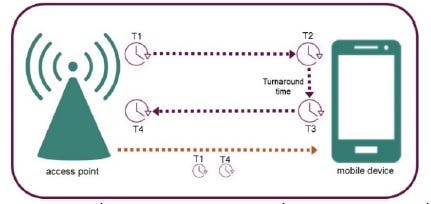Wi-Fi Location Promises Precision
Wi-Fi Alliance unveils method for providing accurate indoor device location.
February 23, 2017

The Wi-Fi Alliance this week introduced technology it says provide highly accurate indoor device location to enable a range of location-based applications
Wi-Fi Certified Location, based on the Fine Timing Measurement protocol in the 802.11-2016 standard, provides what the vendor group describes as "meter-level accuracy" for indoor device location data. The technology determines the distance between two WiFi devices by precisely measuring the time it takes for a WiFi signal to travel from an access point to a client device and back to the AP, Kevin Robinson, Wi-Fi Alliance VP of marketing, said in an interview.
"Indoor GPS is one way to think of it," he told me in an interview.
Other methods for determining indoor location are primarily based on measuring signal strength, but simple RSSI measurements run into accuracy problems when the signal is weak, Robinson said. In that case, it's hard to know if you're far away or whether a wall is obstructing the signal. RSSI fingerprinting is more accurate, but requires site surveys, which become expensive, he said.
The alliance touts Wi-Fi Location as enabling location-based services on existing WiFi infrastructure; there's no need for beacons, for example.

WiFi location.jpg
Robinson ticked off a number of use cases for the new technology, including indoor navigation inside an airport or subway system, asset management to track high-value mobile assessments, and streamlined network management. With Wi-Fi Location, an IT admin could determine the location of a device or laptop experiencing connectivity issues in order to determine whether the problem is an external source of interference or insufficient coverage.
Wi-Fi Location also supports multiple location coordinate systems so that a WiFi device's location can be pinpointed, for example, to the fifth floor of a 20-floor building, an important capability for emergency services, he noted.
"As a user of location services in wireless environments, I think it's great that the alliance is recognizing just how mainstream the use case has become. The new certification program should be tremendously beneficial to device makers, WLAN admins and end users alike," Lee Badman, a wireless network architect and CWNE, told me in an email.
"At the same time, we're also adding more features at the code and driver levels, which means more opportunity for problems if not implemented right," he added. "Stability and predictability of simple client access can't be sacrificed for new features."
Wi-Fi Location deployments won't show up right away. The ecosystem to support the technology will roll out gradually, starting with reference designs and silicon and then roll into handsets and infrastructure, Robinson said. He expects the rollout to continue through this year into 2018.
The first certified products that support Wi-Fi Location include chips from Broadcom, Intel, Marvell, and Qualcomm.
The Wi-Fi Alliance manages the Wi-Fi Certified program that's designed to ensure interoperability between WiFi equipment.
While the idea of precise location data can be creepy to users, the Wi-Fi Alliance says they maintain can maintain their privacy by not turning on location services through their device operating system.
Moreover, Wi-Fi Location is secure because the location data exchange from a mobile device is encrypted via WPA2 with Protected Management Frames, according to the alliance.
About the Author
You May Also Like




